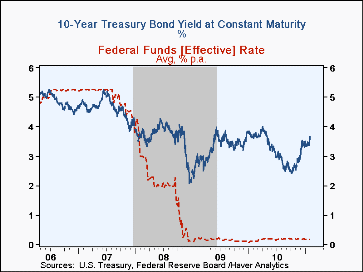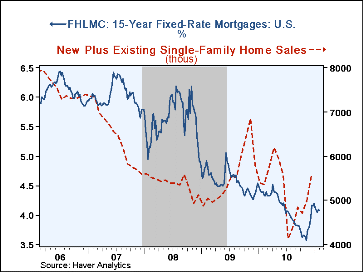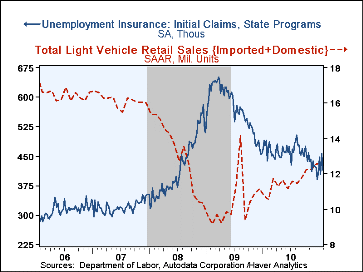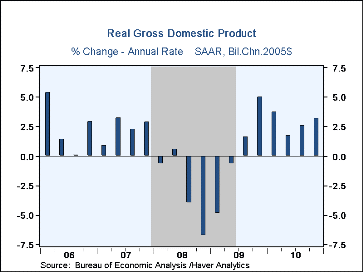 Global| Feb 07 2011
Global| Feb 07 2011U.S. Interest Rates Climb
by:Tom Moeller
|in:Economy in Brief
Summary
What started tentatively last year has turned into somewhat of a rout in the U.S. credit market. While short-term rates have barely budged, long-term rates have risen substantially as recent data suggest the economic recovery is [...]
What started tentatively last year has turned into somewhat of a rout in the U.S. credit market. While short-term rates have barely budged, long-term rates have risen substantially as recent data suggest the economic recovery is gaining some steam. The prospect of the Fed keeping short-term rates low, along with economic improvement, lifted long-term rates to 3.68% last Friday. That's up from the October low of 2.41%. Investors now fear the ultimate inflationary consequences of growth and easy-money, and the need for greater Fed tightening later. Fed Chairman Ben S. Bernanke, however, recently downplayed these inflationary fears.
Mortgage rates rates also have moved up. The rate on 15-year fixed rate mortgages increased to 4.08% last week from its low of 3.57% in early-November. As might be expected rates on adjustable rate mortgages have not risen from the 3.23% low. So far, higher rates have done little or nothing to curb the gain in home sales. Recent figures showed a sharp increase in sales of existing single-family homes and a lesser gain in new home sales. Perhaps sales weakness is pending.
Amongst other indications of a better economy are lower initial claims for jobless insurance, higher motor vehicle sales as well as improved ISM readings on factory and service sector activity. Overall, real GDP growth improved to 3.2% last quarter. Friday's report of weakness in January nonfarm payrolls due to severe winter weather is expected to be temporary. Investor fears of higher interest rates are shared by economists. Through year-end 2011 the National Association for Business Economics (NABE) survey shows short-term rates unchanged from current levels but the 10-year Treasury bond rate is forecasted to be up moderately. These expectations are as of late-November and will be updated later this month.
Interest rate data are available in Haver's USECON, WEEKLY and DAILY databases. The NABE figures can be found in the SURVEYS database.
Fed Chairman Ben S. Bernanke's speech last week to the National Press Club can be found here.
| U.S. Interest Rates (%) | Latest | Jan | Dec | Nov | Jan '10 | 2010 | 2009 | 2008 |
|---|---|---|---|---|---|---|---|---|
| Fed Funds | 0.17 | 0.17 | 0.18 | 0.19 | 0.11 | 0.17 | 0.16 | 1.93 |
| 1 Month Treasury | 0.13 | 0.14 | 0.09 | 0.13 | 0.02 | 0.11 | 0.10 | 1.29 |
| 1 Year Treasury | 0.31 | 0.27 | 0.29 | 0.25 | 0.35 | 0.32 | 0.47 | 1.82 |
| 5 Year Treasury | 2.27 | 1.99 | 1.93 | 1.35 | 2.48 | 1.93 | 2.19 | 2.80 |
| 10 Year Treasury | 3.68 | 3.39 | 3.29 | 2.76 | 3.73 | 3.21 | 3.26 | 3.67 |
| Corporate Bond Aaa | 5.21 | 5.04 | 5.02 | 4.87 | 5.26 | 4.94 | 5.31 | 5.64 |
| 15-Year Fixed Rate Mortgage | 4.08 | 4.09 | 4.06 | 3.68 | 4.46 | 4.10 | 4.58 | 5.63 |
| One-Year ARM | 3.26 | 3.25 | 3.31 | 3.25 | 4.33 | 3.79 | 4.71 | 5.18 |
Tom Moeller
AuthorMore in Author Profile »Prior to joining Haver Analytics in 2000, Mr. Moeller worked as the Economist at Chancellor Capital Management from 1985 to 1999. There, he developed comprehensive economic forecasts and interpreted economic data for equity and fixed income portfolio managers. Also at Chancellor, Mr. Moeller worked as an equity analyst and was responsible for researching and rating companies in the economically sensitive automobile and housing industries for investment in Chancellor’s equity portfolio. Prior to joining Chancellor, Mr. Moeller was an Economist at Citibank from 1979 to 1984. He also analyzed pricing behavior in the metals industry for the Council on Wage and Price Stability in Washington, D.C. In 1999, Mr. Moeller received the award for most accurate forecast from the Forecasters' Club of New York. From 1990 to 1992 he was President of the New York Association for Business Economists. Mr. Moeller earned an M.B.A. in Finance from Fordham University, where he graduated in 1987. He holds a Bachelor of Arts in Economics from George Washington University.










